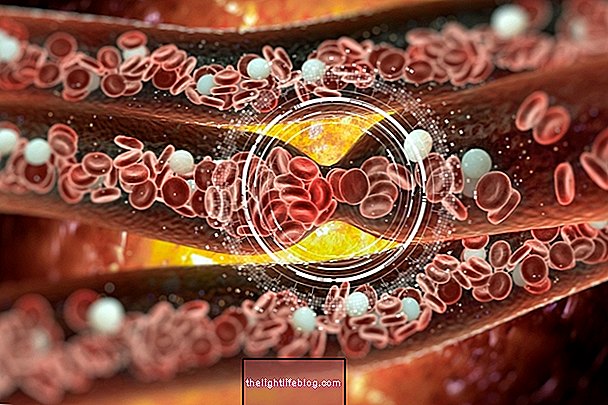Hemochromatosis is a disease in which there is excess iron in the body, favoring the accumulation of this mineral in various organs of the body and the appearance of complications such as cirrhosis of the liver, diabetes, darkening of the skin, heart failure, joint pain or gland dysfunction sexual, for example.
The treatment for hemochromatosis is indicated by the hematologist, with phlebotomies, which are periodically removed from the blood so that the deposited iron is transferred to the new red blood cells that the body produces, and in some cases the use of chelators from the body may also be indicated. iron, as they help in its elimination.

Hemochromatosis symptoms
Hemochromatosis symptoms arise when the levels of iron circulating in the blood are very high, which causes it to be deposited in some organs such as the liver, heart, pancreas, skin, joints, testicles, ovaries, thyroid and pituitary gland. Thus, the main signs and symptoms that may arise are:
- Fatigue;
- Weakness;
- Cirrhosis of the liver;
- Diabetes;
- Heart failure and arrhythmias;
- Joint pain;
- Absence of menstruation.
In addition, in some cases, excess iron can cause sexual impotence, infertility and hypothyroidism. Know other symptoms that indicate excess iron.
How the diagnosis is made
The diagnosis of hemacromatosis is made initially through the evaluation of symptoms and blood tests indicated by the hematologist or general practitioner in order to assess the levels of iron present in the body, in addition to the concentration of ferritin and transferrin saturation, which are related to the storage and transport of iron in the body.
In addition, other tests may be ordered to help investigate the causes of hemochromatosis, and the following may be recommended:
- Genetic tests, which can show changes in the genes that cause the disease;
- Liver biopsy, especially when it has not yet been possible to confirm the disease or to prove the deposit of iron in the liver;
- Response test to phlebotomy, which is done with the withdrawal of blood and monitoring of iron levels, being indicated mainly for people who cannot undergo a liver biopsy or where there are still doubts about the diagnosis;
The hematologist will also be able to request measurements of liver enzymes, investigate the function or deposit of iron in the organs that may be affected, as well as exclude other diseases that may cause similar symptoms.
Hemochromatosis should be investigated in people who have suggestive symptoms, when there is unexplained liver disease, diabetes, heart disease, sexual dysfunction or joint disease, and also in people who have first-degree relatives with the disease or who have changes in the rates of blood tests iron.

Causes of hemochromatosis
Hemochromatosis can happen as a result of genetic changes or as a consequence of diseases related to the destruction of red blood cells, which promotes the release of iron in the blood. Thus, according to the cause, hemochromatosis can be classified into:
- Hereditary hemochromatosis, which is the main cause of the disease and which happens due to mutations in the genes responsible for the absorption of iron in the digestive tract, which start to be absorbed in great quantity, increasing the amount of circulating iron in the body;
- Secondary or acquired hemochromatosis, in which iron accumulation occurs due to other situations, mainly hemoglobinopathies, in which the destruction of red blood cells releases large amounts of iron into the bloodstream. Other causes are repeated blood transfusions, chronic cirrhosis or improper use of anemia medications, for example.
It is important that the cause of hemochromatosis is identified by the doctor, as it is possible that the most appropriate treatment is indicated, helping to prevent complications and alleviate the symptoms caused by excess iron.

How the treatment is done
Hereditary hemochromatosis has no cure, however, treatment can be done as a way to decrease iron stores in the blood and prevent deposits in the organs. Thus, in these cases, the main form of treatment is phlebotomy, also called bleeding, in which part of the blood is removed so that the excess iron becomes part of the new red blood cells that the body produces.
This treatment has a more aggressive initial session, but it is necessary to make maintenance doses, in which approximately 350 to 450 ml of blood are taken 1 to 2 times a week. Then, the sessions can be spaced according to the result of the follow-up exams, indicated by the hematologist.
Another treatment option is through the use of medicines known as iron chelators or "scavengers", such as Desferroxamine, as they promote the reduction of circulating iron levels. This treatment is indicated for people who cannot tolerate phlebotomy, especially those with severe anemia, heart failure or advanced cirrhosis of the liver.
See more details of the treatment for excess iron in the blood.
How should the food be
In addition to the treatment indicated by the doctor, it is also important to pay attention to food, it is recommended to avoid excessive consumption of foods rich in iron. Some guidelines related to food are:
- Avoid eating meat in large quantities, giving preference to white meat;
- Eat fish at least twice a week;
- Avoid eating iron-rich vegetables, such as spinach, beets or green beans, more than once a week;
- Eat wholemeal bread instead of white or iron-enriched bread;
- Eat cheese, milk or yogurt daily because calcium decreases iron absorption;
- Avoid eating dry fruits, such as raisins, in large quantities because it is rich in iron.
In addition, the person should avoid alcoholic beverages in order to avoid liver damage and not to consume vitamin supplements with iron and vitamin C, as this increases the absorption of iron.
Was this information helpful?
Yes No
Your opinion is important! Write here how we can improve our text:
Any questions? Click here to be answered.
Email in which you want to receive a reply:
Check the confirmation email we sent you.
Your name:
Reason for visit:
--- Choose your reason --- DiseaseLive betterHelp another personGain knowledge
Are you a health professional?
NoMedicalPharmaceuticalsNurseNutritionistBiomedicalPhysiotherapistBeauticianOther
Bibliography
- BRAZILIAN SOCIETY OF HEPATOLOGY. Hereditary hemochromatosis: far beyond hfe. Available in: . Accessed on 10 Feb 2021
- IGLESIAS, Cassia P. K .; DUARTE, Paulo Vinicios F .; MIRANDA, Jacqueline S. S. M et al. Hemochromatosis: A Reversible Cause of Heart Failure. International Journal of Cardiovascular Sciences. Vol 31. 3rd ed; 308-311, 2018
- VHL. How to make the diagnosis of hemochromatosis and how to treat / monitor these patients?. Available in: . Accessed on 10 Feb 2021





.jpg)




















